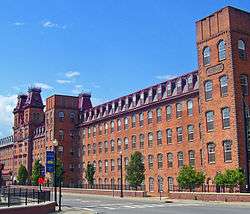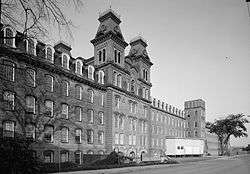Harmony Mills
Harmony Mills, in Cohoes, New York, United States, is an industrial district that is bordered by the Mohawk River and the tracks of the former Troy and Schenectady Railroad (now the Mohawk-Hudson bike trail). It was listed as Harmony Mills Historic District on the National Register of Historic Places in 1978. A portion of the district encompassing the industrial buildings and some of the housing built for millworkers was declared a National Historic Landmark in 1999.[2][3] The centerpiece building, Harmony Mill No. 3 was listed on the National Register of Historic Places in 1971.[1]
Harmony Mills Historic District | |
 Partial front elevation of mill building in 2008 | |
  | |
| Location | Cohoes, NY |
|---|---|
| Coordinates | 42°46′52″N 73°42′15″W |
| Architectural style | Second Empire |
| NRHP reference No. | 78003151 |
| Significant dates | |
| Added to NRHP | January 12, 1978[1] |
| Designated NHLD | January 20, 1999[2] |
It was the largest cotton mill complex in the world when it opened in 1872, and is one of the finest examples of a large-scale textile mill complex outside of New England.
The complex went into decline after its largest tenant, Barclay Home Products, went out of business in 1988. Mill 2 burned down in 1995. Mill 1 suffered devastating damage in a second fire in 1998.
Developer Uri Kaufman purchased the complex in 2000.
In 2005–2006, a portion of Mill 3 was renovated and turned into high-end residential lofts. The 96 loft apartments completed in this first phase were at 100% occupancy by July, 2006. A second phase containing 135 units was completed in 2010, adding a pool and spa and other luxury amenities. This phase—98% leased as of July, 2012—was called Harmony Mills Fallsview Luxury Apartments because of the views of the Cohoes Falls.
A third phase, restoring Mills 1 & 4 was commenced in early 2013. Mill 4 was completed in early December, 2013. 31 of its 33 loft apartments were pre-leased prior to receipt of the Certificate of Occupancy on December 6, 2013. In all, the Harmony Mills now contains 340 luxury loft apartments.
The revival of the Mills sparked a revival of the City of Cohoes. In the 2010 census, the City gained population for the first time since 1930. According to a study by the Center for Economic Growth, Cohoes was the fastest growing city in New York State in both 2015 and 2016.[4] The project has been hailed as a prime example of how adaptive re-use of historic buildings can revitalize cities, while clearing urban blight in an environmentally friendly manner.
For his efforts in restoring the Harmony Mills, Uri Kaufman was awarded the New York State Preservation League Excellence Award.[5] The Harmony Mills is featured on the Home Page of the New York State Historic Preservation Office Website, as a leading example of historic preservation development.[6]
Gallery
 Viewed across Mohawk River, in HAER photo from 1969
Viewed across Mohawk River, in HAER photo from 1969 Harmony Mill No. 3, in 1969
Harmony Mill No. 3, in 1969
See also
- Albany Felt Company Complex, a similar residential conversion of a historic industrial property by the same developer.
- List of National Historic Landmarks in New York
- National Register of Historic Places listings in Albany County, New York
References
- "National Register Information System". National Register of Historic Places. National Park Service. January 23, 2007.
- "Harmony Mills". National Historic Landmark summary listing. National Park Service. 2007-09-14. Archived from the original on 2011-06-05.
- Rachel D. Bliven (June 20, 1998). "National Register of Historic Places Registration: Harmony Mills" (pdf). National Park Service. Cite journal requires
|journal=(help) and Accompanying 18 photos, exterior and interior, from 1994, 1998, and undated. (2.26 MB) - http://www.ceg.org/articles/cohoes-repeats-states-fastest-growing-city/
- http://www.preservenys.org/uploads/3/1/6/2/31626961/pr-harmonymills-final.pdf
- http://nysparks.com/shpo/
- Vogel, Robert M. (1973). "Report of the Mohawk-Hudson Area Survey". Smithsonian Studies in History and Technology (26): 1–210. doi:10.5479/si.00810258.26.1. ISSN 0081-0258.
- Walkowitz, Daniel J. (1981). Worker city, company town : iron and cotton-worker protest in Troy and Cohoes, New York, 1855-84. University of Illinois Press. ISBN 0-252-00915-0. OCLC 993276133.
External links
| Wikimedia Commons has media related to Harmony Mills. |
- Harmony Mills residential lofts
- Historic American Engineering Record (HAER) No. NY-5, "Harmony Manufacturing Company, Mill Number 3, 100 North Mohawk Street, Cohoes, Albany County, NY", 33 photos, 16 data pages, 1 photo caption page
- HAER No. NY-544, "Harmony Manufacturing Company, Mill Number 1, 100 North Mohawk Street, Cohoes, Albany County, NY", 4 photos, 1 photo caption page

